Financial Management: Valuation Techniques, Problems, and Appraisal
VerifiedAdded on 2023/01/11
|15
|3763
|50
Report
AI Summary
This report delves into financial management, exploring various valuation techniques and investment appraisal methods. It begins by explaining the price-earnings ratio, dividend valuation method, and discounted cash flow method, providing calculations and examples for each. The report also addresses the problems associated with these valuation techniques, offering a critical analysis of their limitations. Furthermore, it examines investment appraisal techniques, including the payback period, accounting rate of return, net present value, and internal rate of return, with detailed computations and interpretations. The benefits and limitations of these investment appraisal tools are evaluated, providing a comprehensive understanding of their application in financial decision-making.

FINANCIAL
MANAGEMENT
MANAGEMENT
Paraphrase This Document
Need a fresh take? Get an instant paraphrase of this document with our AI Paraphraser
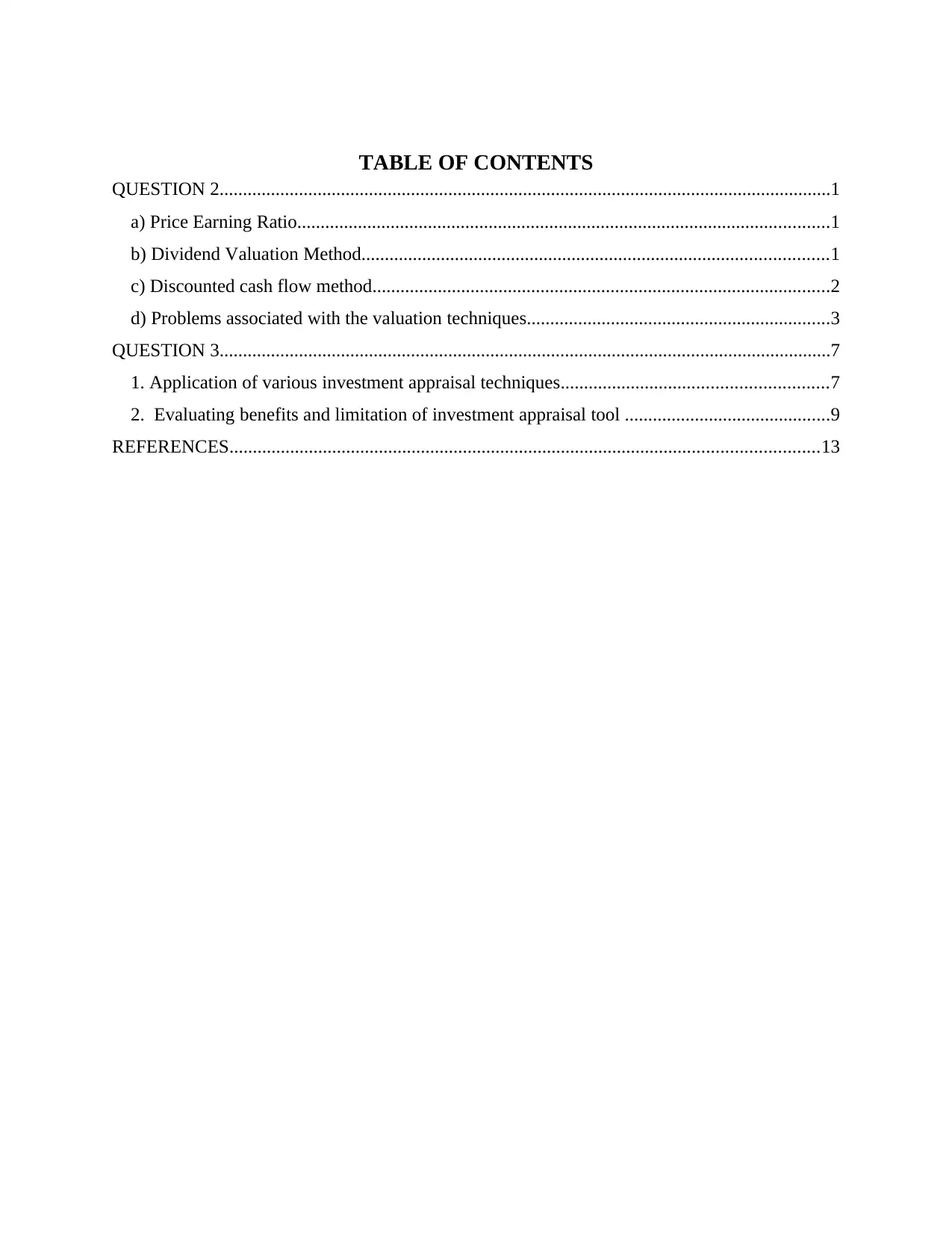
TABLE OF CONTENTS
QUESTION 2...................................................................................................................................1
a) Price Earning Ratio..................................................................................................................1
b) Dividend Valuation Method....................................................................................................1
c) Discounted cash flow method..................................................................................................2
d) Problems associated with the valuation techniques.................................................................3
QUESTION 3...................................................................................................................................7
1. Application of various investment appraisal techniques.........................................................7
2. Evaluating benefits and limitation of investment appraisal tool ............................................9
REFERENCES..............................................................................................................................13
QUESTION 2...................................................................................................................................1
a) Price Earning Ratio..................................................................................................................1
b) Dividend Valuation Method....................................................................................................1
c) Discounted cash flow method..................................................................................................2
d) Problems associated with the valuation techniques.................................................................3
QUESTION 3...................................................................................................................................7
1. Application of various investment appraisal techniques.........................................................7
2. Evaluating benefits and limitation of investment appraisal tool ............................................9
REFERENCES..............................................................................................................................13
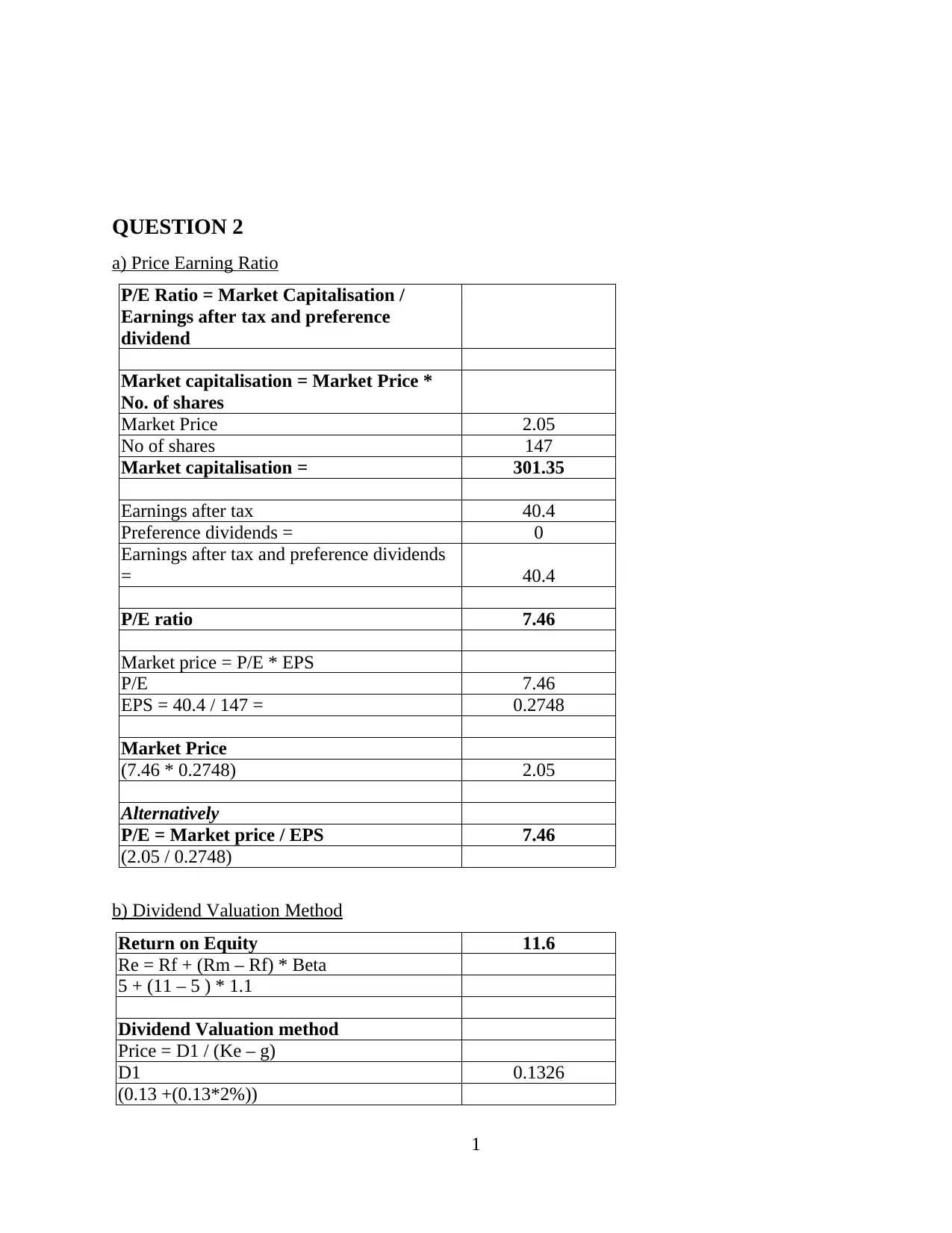
QUESTION 2
a) Price Earning Ratio
P/E Ratio = Market Capitalisation /
Earnings after tax and preference
dividend
Market capitalisation = Market Price *
No. of shares
Market Price 2.05
No of shares 147
Market capitalisation = 301.35
Earnings after tax 40.4
Preference dividends = 0
Earnings after tax and preference dividends
= 40.4
P/E ratio 7.46
Market price = P/E * EPS
P/E 7.46
EPS = 40.4 / 147 = 0.2748
Market Price
(7.46 * 0.2748) 2.05
Alternatively
P/E = Market price / EPS 7.46
(2.05 / 0.2748)
b) Dividend Valuation Method
Return on Equity 11.6
Re = Rf + (Rm – Rf) * Beta
5 + (11 – 5 ) * 1.1
Dividend Valuation method
Price = D1 / (Ke – g)
D1 0.1326
(0.13 +(0.13*2%))
1
a) Price Earning Ratio
P/E Ratio = Market Capitalisation /
Earnings after tax and preference
dividend
Market capitalisation = Market Price *
No. of shares
Market Price 2.05
No of shares 147
Market capitalisation = 301.35
Earnings after tax 40.4
Preference dividends = 0
Earnings after tax and preference dividends
= 40.4
P/E ratio 7.46
Market price = P/E * EPS
P/E 7.46
EPS = 40.4 / 147 = 0.2748
Market Price
(7.46 * 0.2748) 2.05
Alternatively
P/E = Market price / EPS 7.46
(2.05 / 0.2748)
b) Dividend Valuation Method
Return on Equity 11.6
Re = Rf + (Rm – Rf) * Beta
5 + (11 – 5 ) * 1.1
Dividend Valuation method
Price = D1 / (Ke – g)
D1 0.1326
(0.13 +(0.13*2%))
1
⊘ This is a preview!⊘
Do you want full access?
Subscribe today to unlock all pages.

Trusted by 1+ million students worldwide
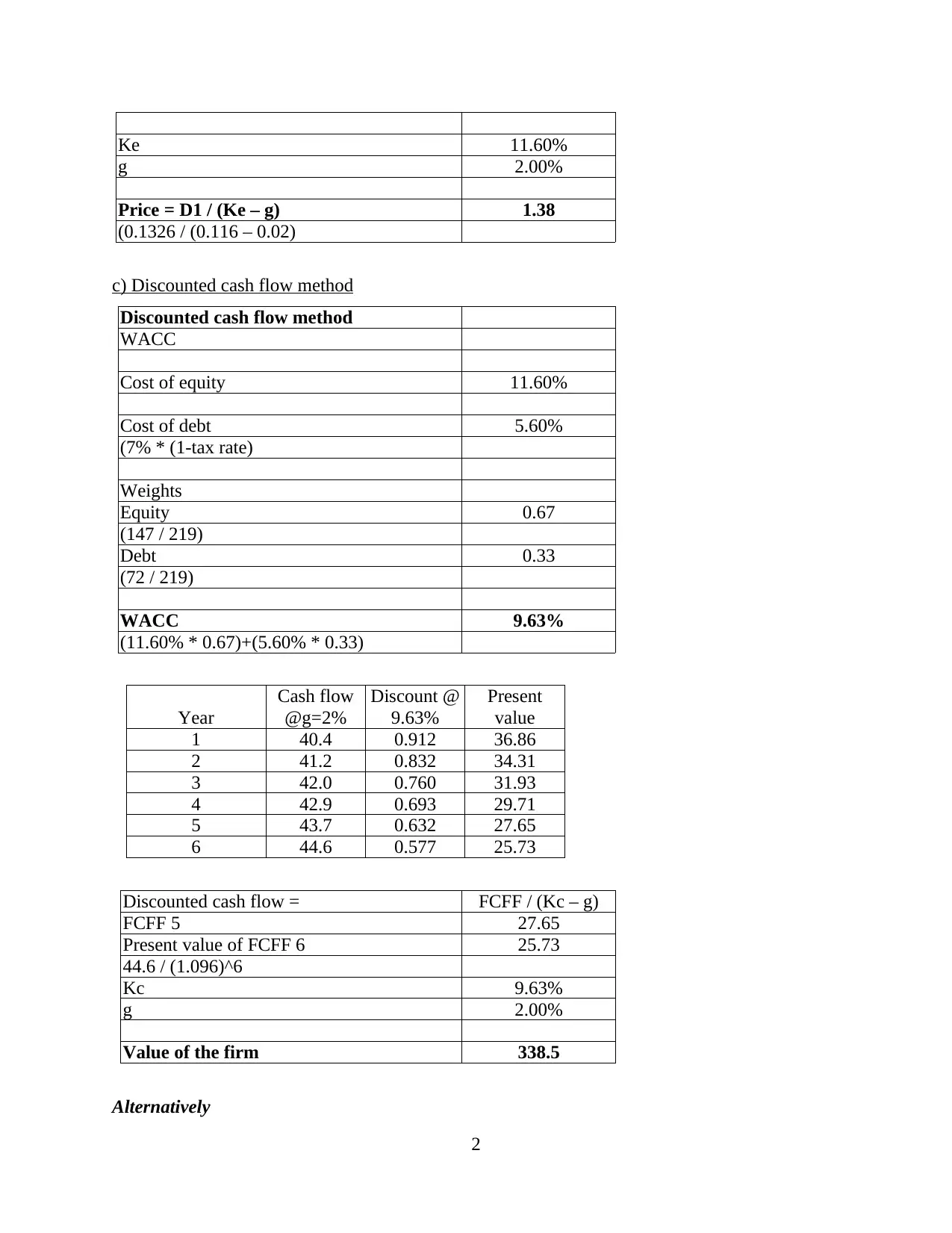
Ke 11.60%
g 2.00%
Price = D1 / (Ke – g) 1.38
(0.1326 / (0.116 – 0.02)
c) Discounted cash flow method
Discounted cash flow method
WACC
Cost of equity 11.60%
Cost of debt 5.60%
(7% * (1-tax rate)
Weights
Equity 0.67
(147 / 219)
Debt 0.33
(72 / 219)
WACC 9.63%
(11.60% * 0.67)+(5.60% * 0.33)
Year
Cash flow
@g=2%
Discount @
9.63%
Present
value
1 40.4 0.912 36.86
2 41.2 0.832 34.31
3 42.0 0.760 31.93
4 42.9 0.693 29.71
5 43.7 0.632 27.65
6 44.6 0.577 25.73
Discounted cash flow = FCFF / (Kc – g)
FCFF 5 27.65
Present value of FCFF 6 25.73
44.6 / (1.096)^6
Kc 9.63%
g 2.00%
Value of the firm 338.5
Alternatively
2
g 2.00%
Price = D1 / (Ke – g) 1.38
(0.1326 / (0.116 – 0.02)
c) Discounted cash flow method
Discounted cash flow method
WACC
Cost of equity 11.60%
Cost of debt 5.60%
(7% * (1-tax rate)
Weights
Equity 0.67
(147 / 219)
Debt 0.33
(72 / 219)
WACC 9.63%
(11.60% * 0.67)+(5.60% * 0.33)
Year
Cash flow
@g=2%
Discount @
9.63%
Present
value
1 40.4 0.912 36.86
2 41.2 0.832 34.31
3 42.0 0.760 31.93
4 42.9 0.693 29.71
5 43.7 0.632 27.65
6 44.6 0.577 25.73
Discounted cash flow = FCFF / (Kc – g)
FCFF 5 27.65
Present value of FCFF 6 25.73
44.6 / (1.096)^6
Kc 9.63%
g 2.00%
Value of the firm 338.5
Alternatively
2
Paraphrase This Document
Need a fresh take? Get an instant paraphrase of this document with our AI Paraphraser
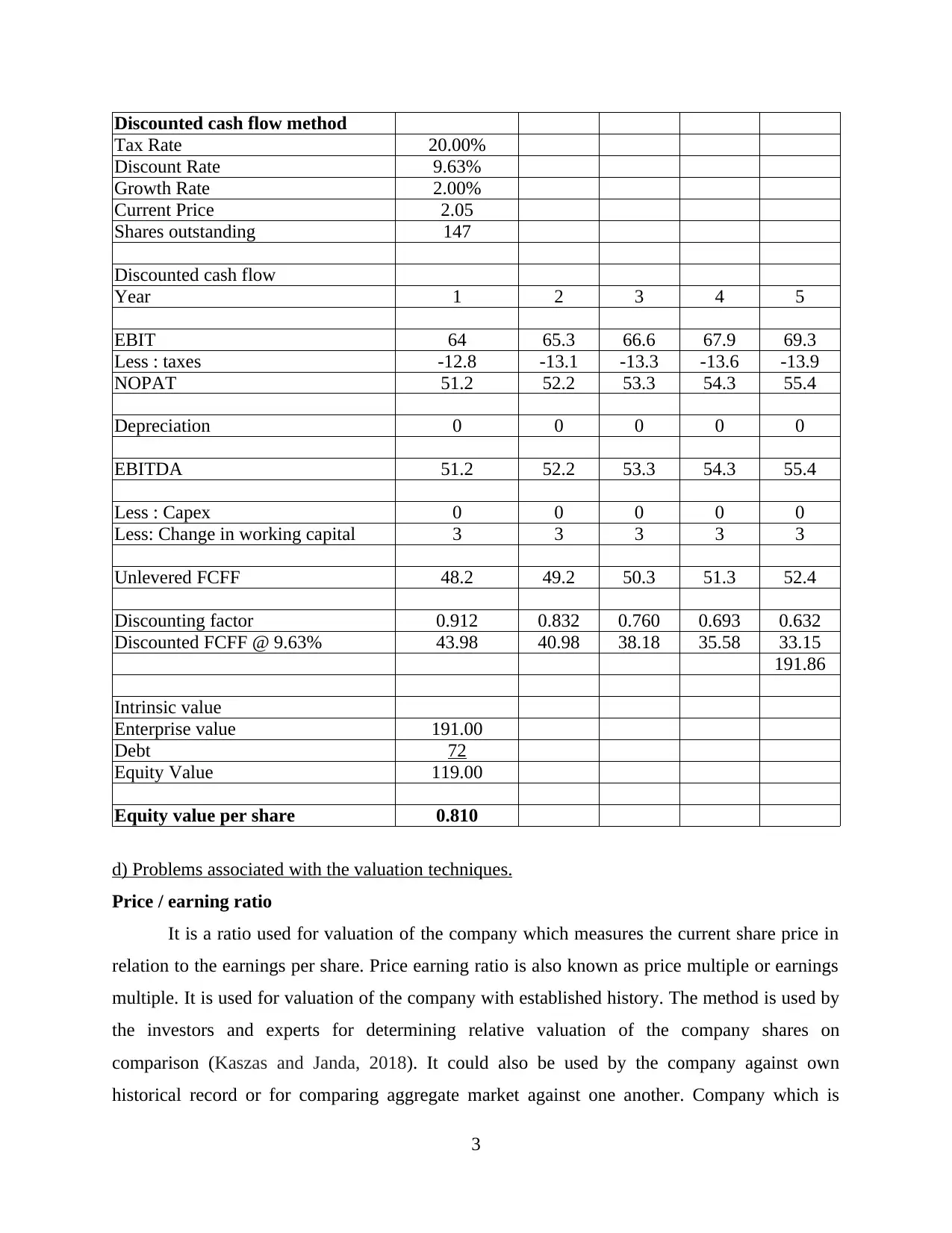
Discounted cash flow method
Tax Rate 20.00%
Discount Rate 9.63%
Growth Rate 2.00%
Current Price 2.05
Shares outstanding 147
Discounted cash flow
Year 1 2 3 4 5
EBIT 64 65.3 66.6 67.9 69.3
Less : taxes -12.8 -13.1 -13.3 -13.6 -13.9
NOPAT 51.2 52.2 53.3 54.3 55.4
Depreciation 0 0 0 0 0
EBITDA 51.2 52.2 53.3 54.3 55.4
Less : Capex 0 0 0 0 0
Less: Change in working capital 3 3 3 3 3
Unlevered FCFF 48.2 49.2 50.3 51.3 52.4
Discounting factor 0.912 0.832 0.760 0.693 0.632
Discounted FCFF @ 9.63% 43.98 40.98 38.18 35.58 33.15
191.86
Intrinsic value
Enterprise value 191.00
Debt 72
Equity Value 119.00
Equity value per share 0.810
d) Problems associated with the valuation techniques.
Price / earning ratio
It is a ratio used for valuation of the company which measures the current share price in
relation to the earnings per share. Price earning ratio is also known as price multiple or earnings
multiple. It is used for valuation of the company with established history. The method is used by
the investors and experts for determining relative valuation of the company shares on
comparison (Kaszas and Janda, 2018). It could also be used by the company against own
historical record or for comparing aggregate market against one another. Company which is
3
Tax Rate 20.00%
Discount Rate 9.63%
Growth Rate 2.00%
Current Price 2.05
Shares outstanding 147
Discounted cash flow
Year 1 2 3 4 5
EBIT 64 65.3 66.6 67.9 69.3
Less : taxes -12.8 -13.1 -13.3 -13.6 -13.9
NOPAT 51.2 52.2 53.3 54.3 55.4
Depreciation 0 0 0 0 0
EBITDA 51.2 52.2 53.3 54.3 55.4
Less : Capex 0 0 0 0 0
Less: Change in working capital 3 3 3 3 3
Unlevered FCFF 48.2 49.2 50.3 51.3 52.4
Discounting factor 0.912 0.832 0.760 0.693 0.632
Discounted FCFF @ 9.63% 43.98 40.98 38.18 35.58 33.15
191.86
Intrinsic value
Enterprise value 191.00
Debt 72
Equity Value 119.00
Equity value per share 0.810
d) Problems associated with the valuation techniques.
Price / earning ratio
It is a ratio used for valuation of the company which measures the current share price in
relation to the earnings per share. Price earning ratio is also known as price multiple or earnings
multiple. It is used for valuation of the company with established history. The method is used by
the investors and experts for determining relative valuation of the company shares on
comparison (Kaszas and Janda, 2018). It could also be used by the company against own
historical record or for comparing aggregate market against one another. Company which is
3
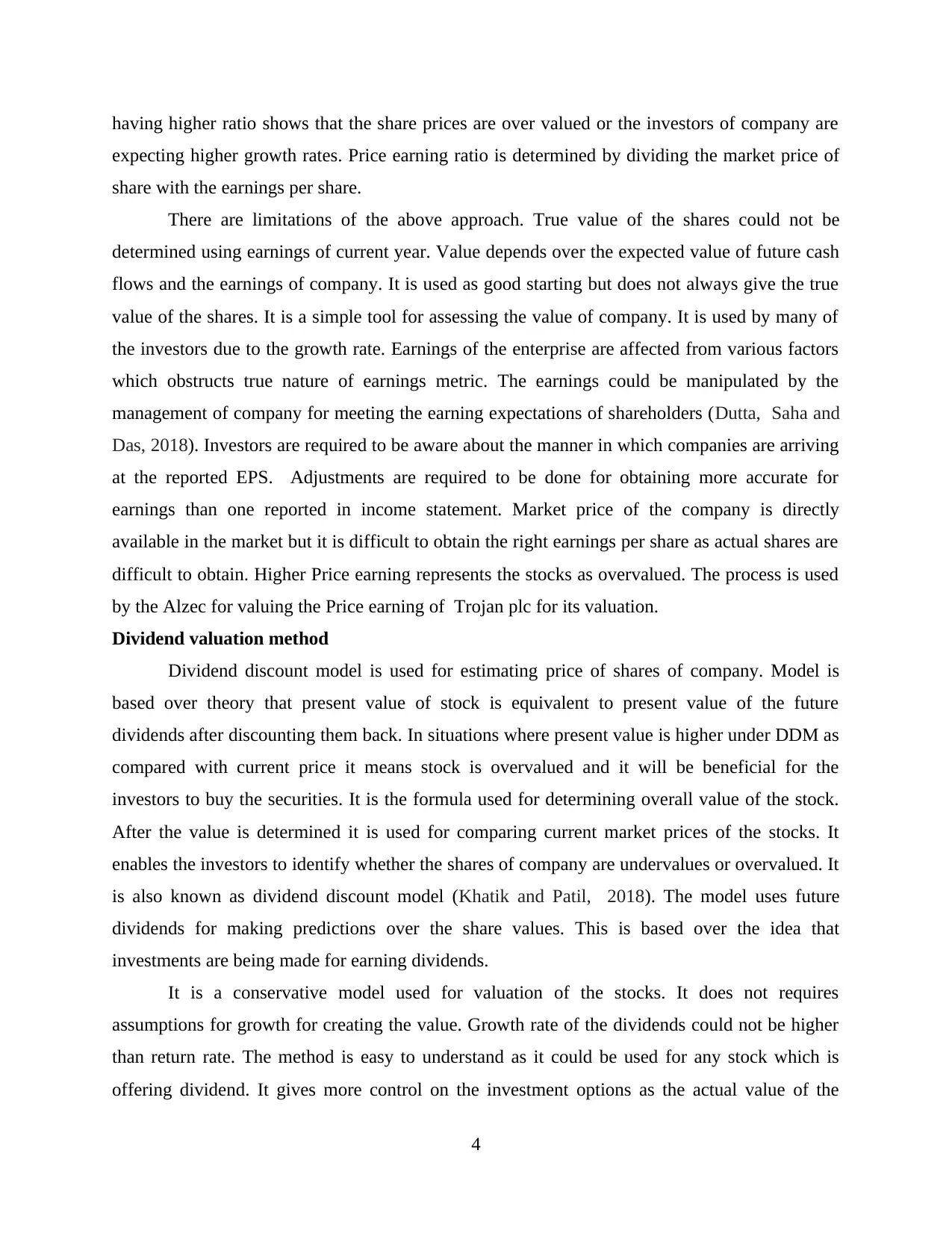
having higher ratio shows that the share prices are over valued or the investors of company are
expecting higher growth rates. Price earning ratio is determined by dividing the market price of
share with the earnings per share.
There are limitations of the above approach. True value of the shares could not be
determined using earnings of current year. Value depends over the expected value of future cash
flows and the earnings of company. It is used as good starting but does not always give the true
value of the shares. It is a simple tool for assessing the value of company. It is used by many of
the investors due to the growth rate. Earnings of the enterprise are affected from various factors
which obstructs true nature of earnings metric. The earnings could be manipulated by the
management of company for meeting the earning expectations of shareholders (Dutta, Saha and
Das, 2018). Investors are required to be aware about the manner in which companies are arriving
at the reported EPS. Adjustments are required to be done for obtaining more accurate for
earnings than one reported in income statement. Market price of the company is directly
available in the market but it is difficult to obtain the right earnings per share as actual shares are
difficult to obtain. Higher Price earning represents the stocks as overvalued. The process is used
by the Alzec for valuing the Price earning of Trojan plc for its valuation.
Dividend valuation method
Dividend discount model is used for estimating price of shares of company. Model is
based over theory that present value of stock is equivalent to present value of the future
dividends after discounting them back. In situations where present value is higher under DDM as
compared with current price it means stock is overvalued and it will be beneficial for the
investors to buy the securities. It is the formula used for determining overall value of the stock.
After the value is determined it is used for comparing current market prices of the stocks. It
enables the investors to identify whether the shares of company are undervalues or overvalued. It
is also known as dividend discount model (Khatik and Patil, 2018). The model uses future
dividends for making predictions over the share values. This is based over the idea that
investments are being made for earning dividends.
It is a conservative model used for valuation of the stocks. It does not requires
assumptions for growth for creating the value. Growth rate of the dividends could not be higher
than return rate. The method is easy to understand as it could be used for any stock which is
offering dividend. It gives more control on the investment options as the actual value of the
4
expecting higher growth rates. Price earning ratio is determined by dividing the market price of
share with the earnings per share.
There are limitations of the above approach. True value of the shares could not be
determined using earnings of current year. Value depends over the expected value of future cash
flows and the earnings of company. It is used as good starting but does not always give the true
value of the shares. It is a simple tool for assessing the value of company. It is used by many of
the investors due to the growth rate. Earnings of the enterprise are affected from various factors
which obstructs true nature of earnings metric. The earnings could be manipulated by the
management of company for meeting the earning expectations of shareholders (Dutta, Saha and
Das, 2018). Investors are required to be aware about the manner in which companies are arriving
at the reported EPS. Adjustments are required to be done for obtaining more accurate for
earnings than one reported in income statement. Market price of the company is directly
available in the market but it is difficult to obtain the right earnings per share as actual shares are
difficult to obtain. Higher Price earning represents the stocks as overvalued. The process is used
by the Alzec for valuing the Price earning of Trojan plc for its valuation.
Dividend valuation method
Dividend discount model is used for estimating price of shares of company. Model is
based over theory that present value of stock is equivalent to present value of the future
dividends after discounting them back. In situations where present value is higher under DDM as
compared with current price it means stock is overvalued and it will be beneficial for the
investors to buy the securities. It is the formula used for determining overall value of the stock.
After the value is determined it is used for comparing current market prices of the stocks. It
enables the investors to identify whether the shares of company are undervalues or overvalued. It
is also known as dividend discount model (Khatik and Patil, 2018). The model uses future
dividends for making predictions over the share values. This is based over the idea that
investments are being made for earning dividends.
It is a conservative model used for valuation of the stocks. It does not requires
assumptions for growth for creating the value. Growth rate of the dividends could not be higher
than return rate. The method is easy to understand as it could be used for any stock which is
offering dividend. It gives more control on the investment options as the actual value of the
4
⊘ This is a preview!⊘
Do you want full access?
Subscribe today to unlock all pages.

Trusted by 1+ million students worldwide

shares is easily identified. It gives the time to investors for comparing the stock which are
overpriced. Investors use the model for growing value of the portfolio. The model provides the
base to decide about the investment plan when investors decide to make investments over several
stocks.
There are also some drawbacks associated with the method. In the real market value of
dividend do not grow at specific rate till end of the period. Some firm may increase where some
may decrease the dividends which makes the comparison irrelevant. The method is applicable
only on the companies that pay dividends which makes the comparison between small cap and
large companies vague. Dividend discount model does not consider the non dividend factor in
the calculations such as brand loyalty, customer retention and ownership of the intangible assets.
It means valuation model will not be producing desired results even it is calculated correctly. The
method values dividends as the return over investment (Prohaska, Uroda and Peša, 2017).
Discounted cash flow method
It is a valuation technique which is used by the company for projecting the future cah
flows and using net present value method for valuing the cash flows. In this analysis cash flows
of the company are projected using various assumptions like business will be performing in
future and forecasting how the business performance is translated into cash flows which are
generated by business. It is used in various situations as measures value created by the business
directly. It is most theoretically right valuation method. Value of firm is determined from
inherent value of the future cash flows. It is broadly used technique of valuation because of the
theoretical underpinning and ability of using all the scenarios. It is used by corporate finance,
investment bankers and professional of business developments. Valuation which is obtained is
sensitive to various assumptions and forecasts that could vary over wide range. One wrong
assumptions could lead the valuation to go over completely different direction. DCF involve
prediction of the future event over most reliable estimates. The method do not consider market
related information for the valuation like valuation of the comparable firms. The method is
suggested to be done along with other method that consider market forces in the valuation.
It is extremely useful tool when growth rate assumed for series of the period is justifiable
by operating performance of company (Wu and et.al., 2016). It is difficult to estimate growth
rate accurately and correctly. Calculation of the WACC may not be applicable over the real
world. It requires also the projections to be made for capital expenditures in the coming years. In
5
overpriced. Investors use the model for growing value of the portfolio. The model provides the
base to decide about the investment plan when investors decide to make investments over several
stocks.
There are also some drawbacks associated with the method. In the real market value of
dividend do not grow at specific rate till end of the period. Some firm may increase where some
may decrease the dividends which makes the comparison irrelevant. The method is applicable
only on the companies that pay dividends which makes the comparison between small cap and
large companies vague. Dividend discount model does not consider the non dividend factor in
the calculations such as brand loyalty, customer retention and ownership of the intangible assets.
It means valuation model will not be producing desired results even it is calculated correctly. The
method values dividends as the return over investment (Prohaska, Uroda and Peša, 2017).
Discounted cash flow method
It is a valuation technique which is used by the company for projecting the future cah
flows and using net present value method for valuing the cash flows. In this analysis cash flows
of the company are projected using various assumptions like business will be performing in
future and forecasting how the business performance is translated into cash flows which are
generated by business. It is used in various situations as measures value created by the business
directly. It is most theoretically right valuation method. Value of firm is determined from
inherent value of the future cash flows. It is broadly used technique of valuation because of the
theoretical underpinning and ability of using all the scenarios. It is used by corporate finance,
investment bankers and professional of business developments. Valuation which is obtained is
sensitive to various assumptions and forecasts that could vary over wide range. One wrong
assumptions could lead the valuation to go over completely different direction. DCF involve
prediction of the future event over most reliable estimates. The method do not consider market
related information for the valuation like valuation of the comparable firms. The method is
suggested to be done along with other method that consider market forces in the valuation.
It is extremely useful tool when growth rate assumed for series of the period is justifiable
by operating performance of company (Wu and et.al., 2016). It is difficult to estimate growth
rate accurately and correctly. Calculation of the WACC may not be applicable over the real
world. It requires also the projections to be made for capital expenditures in the coming years. In
5
Paraphrase This Document
Need a fresh take? Get an instant paraphrase of this document with our AI Paraphraser
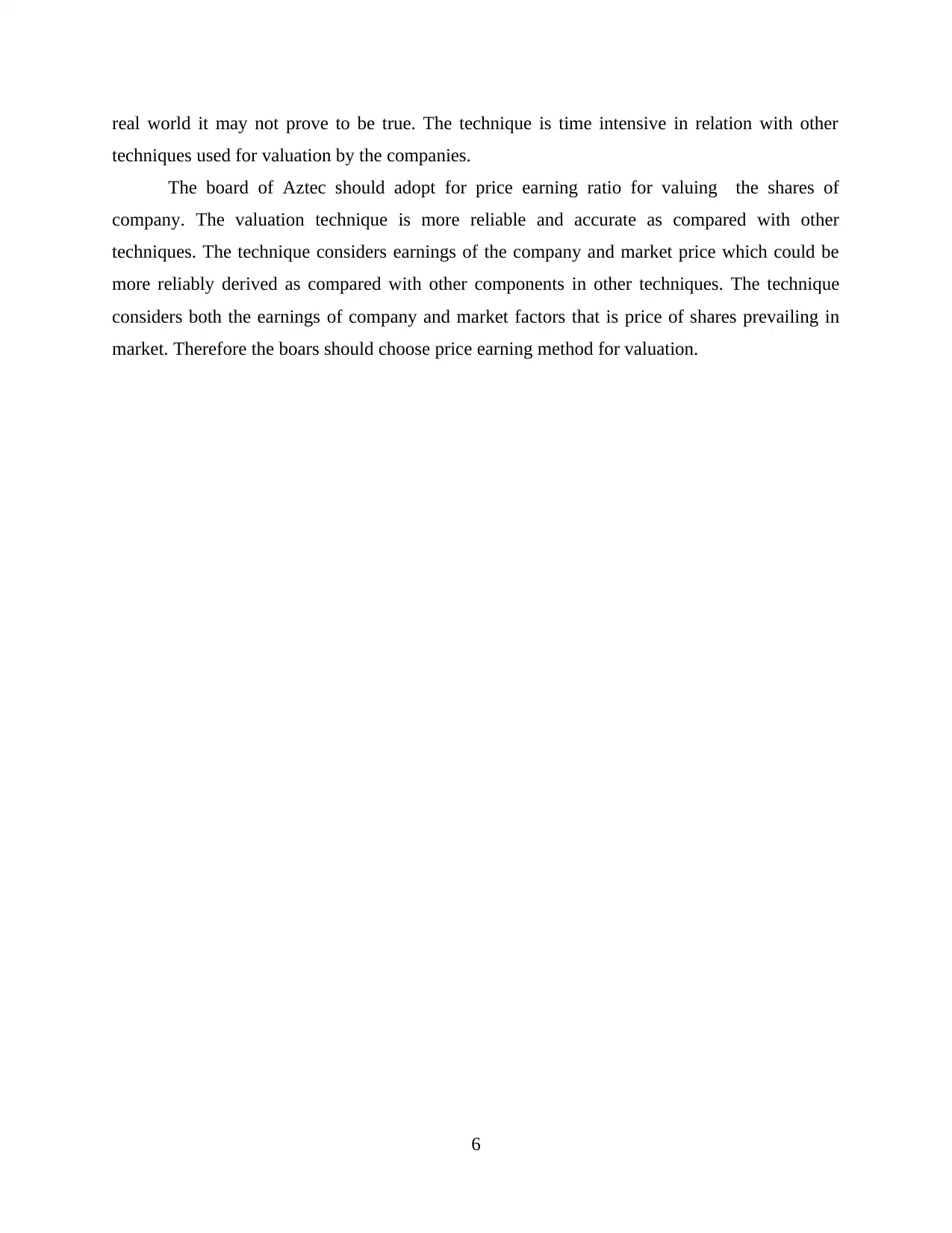
real world it may not prove to be true. The technique is time intensive in relation with other
techniques used for valuation by the companies.
The board of Aztec should adopt for price earning ratio for valuing the shares of
company. The valuation technique is more reliable and accurate as compared with other
techniques. The technique considers earnings of the company and market price which could be
more reliably derived as compared with other components in other techniques. The technique
considers both the earnings of company and market factors that is price of shares prevailing in
market. Therefore the boars should choose price earning method for valuation.
6
techniques used for valuation by the companies.
The board of Aztec should adopt for price earning ratio for valuing the shares of
company. The valuation technique is more reliable and accurate as compared with other
techniques. The technique considers earnings of the company and market price which could be
more reliably derived as compared with other components in other techniques. The technique
considers both the earnings of company and market factors that is price of shares prevailing in
market. Therefore the boars should choose price earning method for valuation.
6
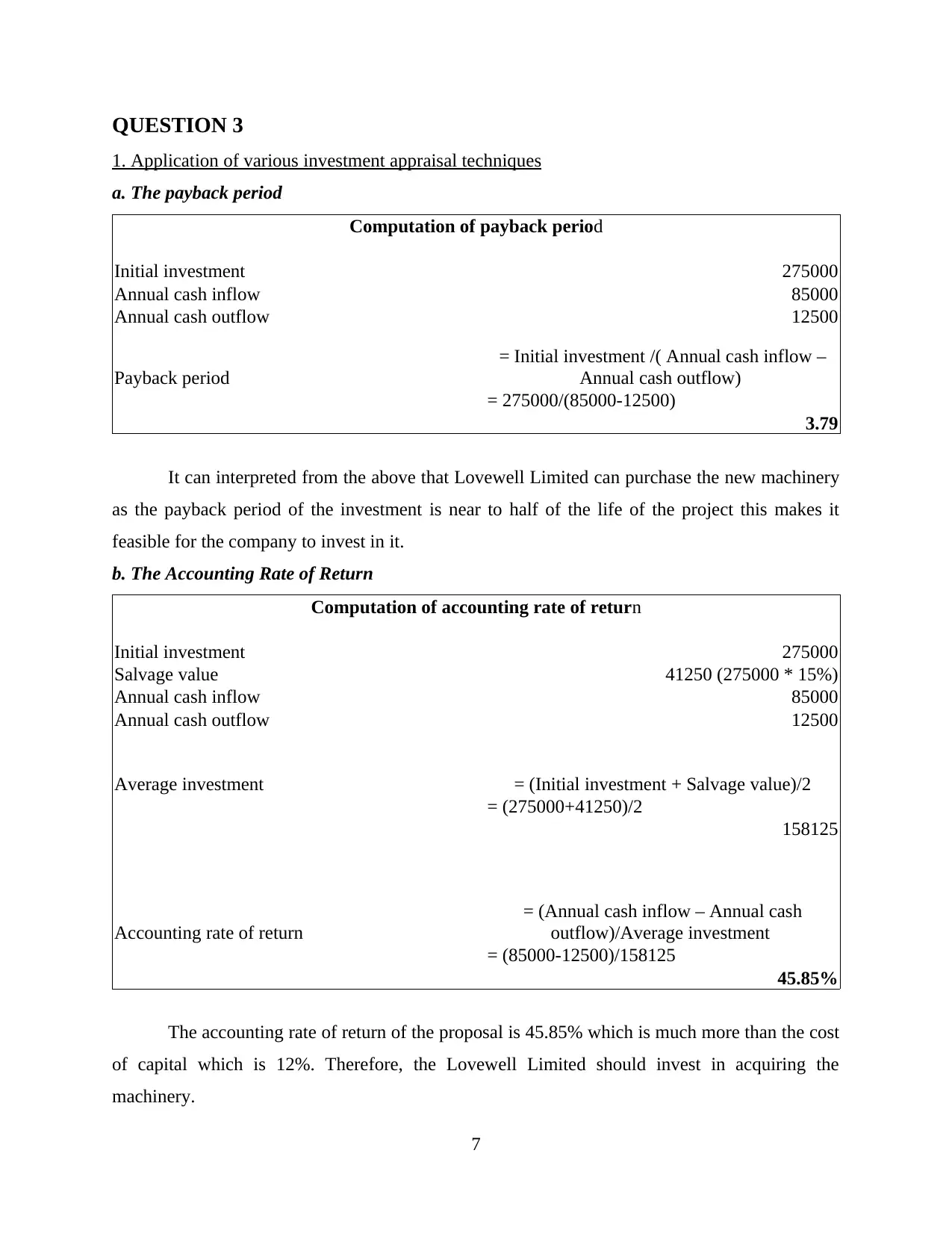
QUESTION 3
1. Application of various investment appraisal techniques
a. The payback period
Computation of payback period
Initial investment 275000
Annual cash inflow 85000
Annual cash outflow 12500
Payback period
= Initial investment /( Annual cash inflow –
Annual cash outflow)
= 275000/(85000-12500)
3.79
It can interpreted from the above that Lovewell Limited can purchase the new machinery
as the payback period of the investment is near to half of the life of the project this makes it
feasible for the company to invest in it.
b. The Accounting Rate of Return
Computation of accounting rate of return
Initial investment 275000
Salvage value 41250 (275000 * 15%)
Annual cash inflow 85000
Annual cash outflow 12500
Average investment = (Initial investment + Salvage value)/2
= (275000+41250)/2
158125
Accounting rate of return
= (Annual cash inflow – Annual cash
outflow)/Average investment
= (85000-12500)/158125
45.85%
The accounting rate of return of the proposal is 45.85% which is much more than the cost
of capital which is 12%. Therefore, the Lovewell Limited should invest in acquiring the
machinery.
7
1. Application of various investment appraisal techniques
a. The payback period
Computation of payback period
Initial investment 275000
Annual cash inflow 85000
Annual cash outflow 12500
Payback period
= Initial investment /( Annual cash inflow –
Annual cash outflow)
= 275000/(85000-12500)
3.79
It can interpreted from the above that Lovewell Limited can purchase the new machinery
as the payback period of the investment is near to half of the life of the project this makes it
feasible for the company to invest in it.
b. The Accounting Rate of Return
Computation of accounting rate of return
Initial investment 275000
Salvage value 41250 (275000 * 15%)
Annual cash inflow 85000
Annual cash outflow 12500
Average investment = (Initial investment + Salvage value)/2
= (275000+41250)/2
158125
Accounting rate of return
= (Annual cash inflow – Annual cash
outflow)/Average investment
= (85000-12500)/158125
45.85%
The accounting rate of return of the proposal is 45.85% which is much more than the cost
of capital which is 12%. Therefore, the Lovewell Limited should invest in acquiring the
machinery.
7
⊘ This is a preview!⊘
Do you want full access?
Subscribe today to unlock all pages.

Trusted by 1+ million students worldwide
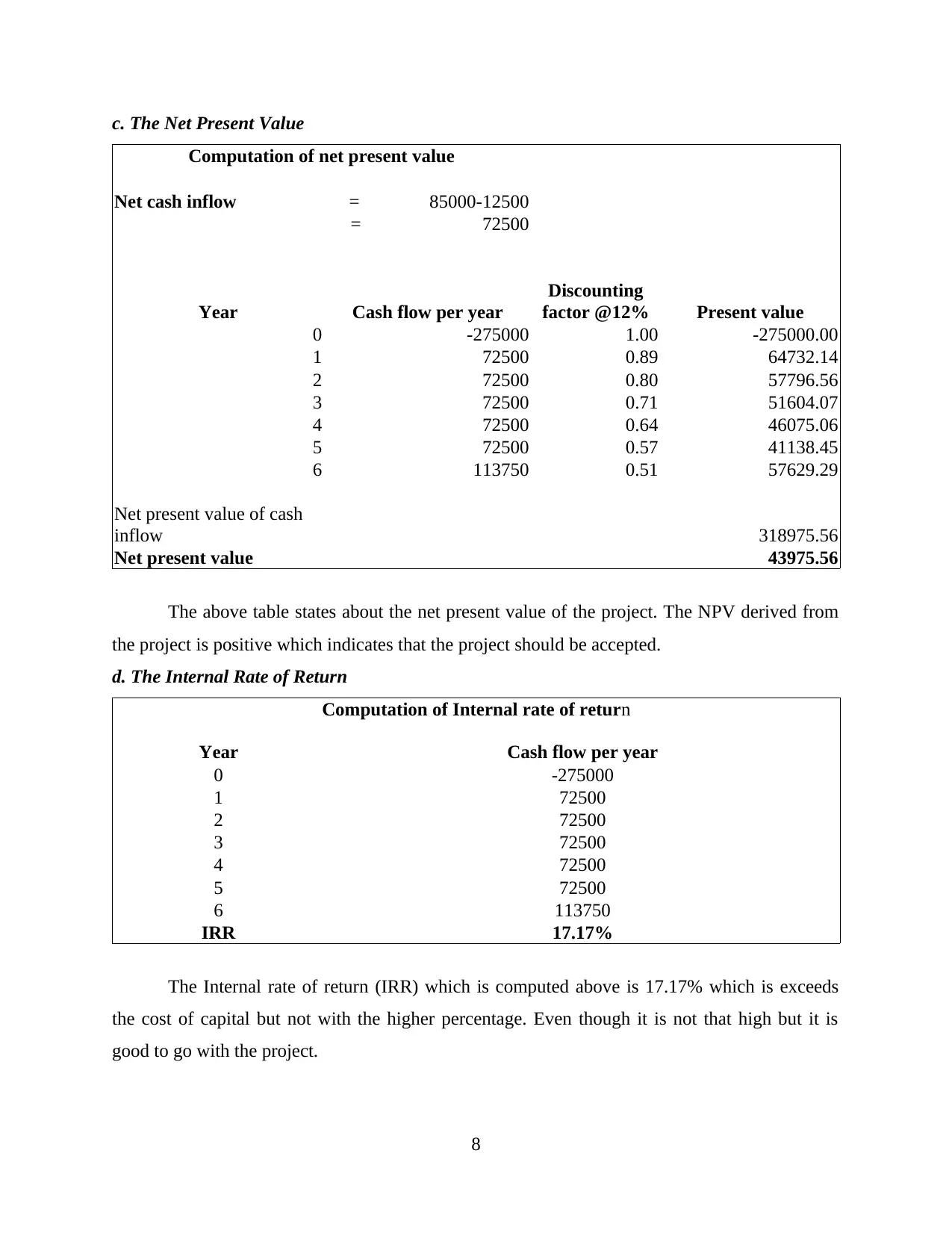
c. The Net Present Value
Computation of net present value
Net cash inflow = 85000-12500
= 72500
Year Cash flow per year
Discounting
factor @12% Present value
0 -275000 1.00 -275000.00
1 72500 0.89 64732.14
2 72500 0.80 57796.56
3 72500 0.71 51604.07
4 72500 0.64 46075.06
5 72500 0.57 41138.45
6 113750 0.51 57629.29
Net present value of cash
inflow 318975.56
Net present value 43975.56
The above table states about the net present value of the project. The NPV derived from
the project is positive which indicates that the project should be accepted.
d. The Internal Rate of Return
Computation of Internal rate of return
Year Cash flow per year
0 -275000
1 72500
2 72500
3 72500
4 72500
5 72500
6 113750
IRR 17.17%
The Internal rate of return (IRR) which is computed above is 17.17% which is exceeds
the cost of capital but not with the higher percentage. Even though it is not that high but it is
good to go with the project.
8
Computation of net present value
Net cash inflow = 85000-12500
= 72500
Year Cash flow per year
Discounting
factor @12% Present value
0 -275000 1.00 -275000.00
1 72500 0.89 64732.14
2 72500 0.80 57796.56
3 72500 0.71 51604.07
4 72500 0.64 46075.06
5 72500 0.57 41138.45
6 113750 0.51 57629.29
Net present value of cash
inflow 318975.56
Net present value 43975.56
The above table states about the net present value of the project. The NPV derived from
the project is positive which indicates that the project should be accepted.
d. The Internal Rate of Return
Computation of Internal rate of return
Year Cash flow per year
0 -275000
1 72500
2 72500
3 72500
4 72500
5 72500
6 113750
IRR 17.17%
The Internal rate of return (IRR) which is computed above is 17.17% which is exceeds
the cost of capital but not with the higher percentage. Even though it is not that high but it is
good to go with the project.
8
Paraphrase This Document
Need a fresh take? Get an instant paraphrase of this document with our AI Paraphraser
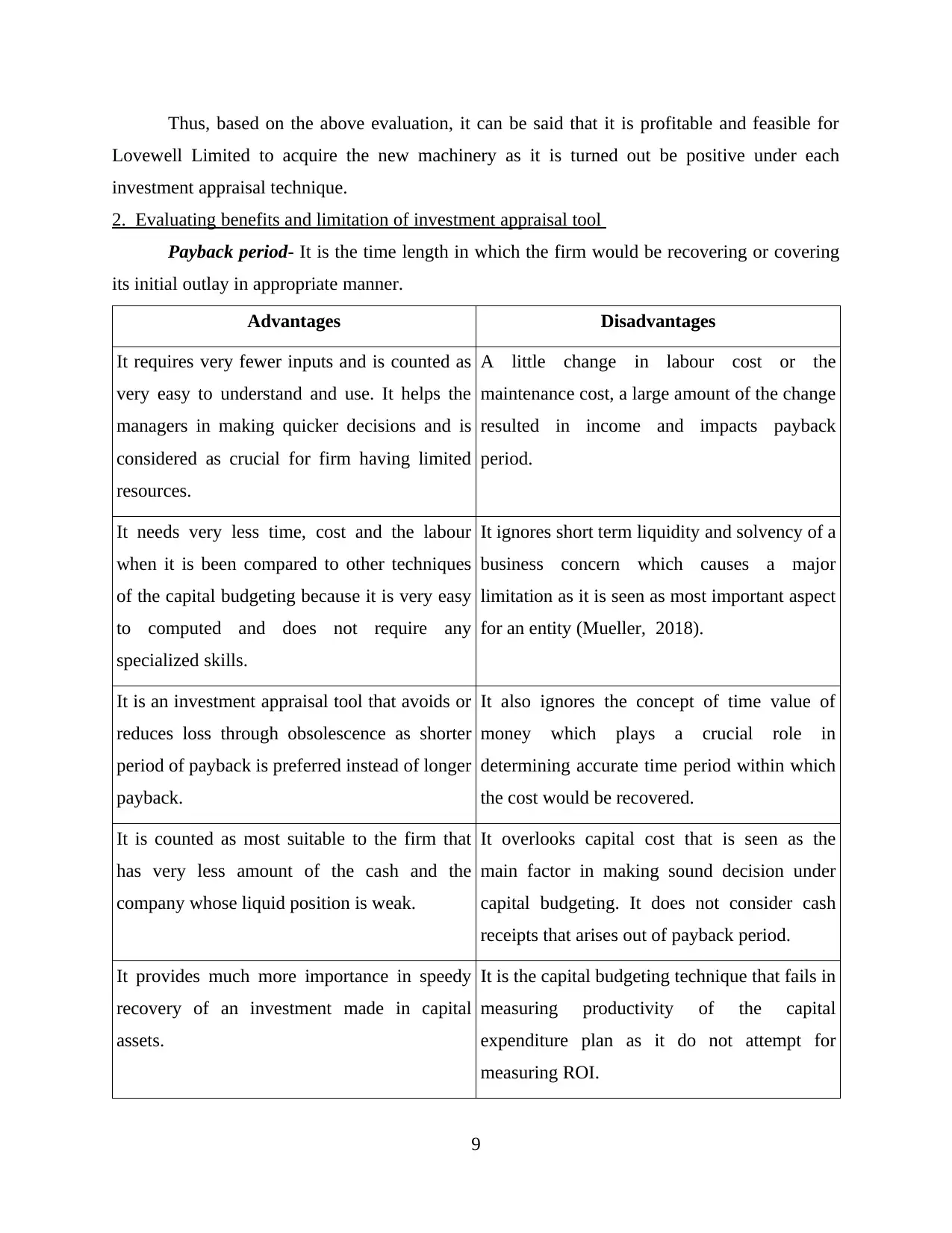
Thus, based on the above evaluation, it can be said that it is profitable and feasible for
Lovewell Limited to acquire the new machinery as it is turned out be positive under each
investment appraisal technique.
2. Evaluating benefits and limitation of investment appraisal tool
Payback period- It is the time length in which the firm would be recovering or covering
its initial outlay in appropriate manner.
Advantages Disadvantages
It requires very fewer inputs and is counted as
very easy to understand and use. It helps the
managers in making quicker decisions and is
considered as crucial for firm having limited
resources.
A little change in labour cost or the
maintenance cost, a large amount of the change
resulted in income and impacts payback
period.
It needs very less time, cost and the labour
when it is been compared to other techniques
of the capital budgeting because it is very easy
to computed and does not require any
specialized skills.
It ignores short term liquidity and solvency of a
business concern which causes a major
limitation as it is seen as most important aspect
for an entity (Mueller, 2018).
It is an investment appraisal tool that avoids or
reduces loss through obsolescence as shorter
period of payback is preferred instead of longer
payback.
It also ignores the concept of time value of
money which plays a crucial role in
determining accurate time period within which
the cost would be recovered.
It is counted as most suitable to the firm that
has very less amount of the cash and the
company whose liquid position is weak.
It overlooks capital cost that is seen as the
main factor in making sound decision under
capital budgeting. It does not consider cash
receipts that arises out of payback period.
It provides much more importance in speedy
recovery of an investment made in capital
assets.
It is the capital budgeting technique that fails in
measuring productivity of the capital
expenditure plan as it do not attempt for
measuring ROI.
9
Lovewell Limited to acquire the new machinery as it is turned out be positive under each
investment appraisal technique.
2. Evaluating benefits and limitation of investment appraisal tool
Payback period- It is the time length in which the firm would be recovering or covering
its initial outlay in appropriate manner.
Advantages Disadvantages
It requires very fewer inputs and is counted as
very easy to understand and use. It helps the
managers in making quicker decisions and is
considered as crucial for firm having limited
resources.
A little change in labour cost or the
maintenance cost, a large amount of the change
resulted in income and impacts payback
period.
It needs very less time, cost and the labour
when it is been compared to other techniques
of the capital budgeting because it is very easy
to computed and does not require any
specialized skills.
It ignores short term liquidity and solvency of a
business concern which causes a major
limitation as it is seen as most important aspect
for an entity (Mueller, 2018).
It is an investment appraisal tool that avoids or
reduces loss through obsolescence as shorter
period of payback is preferred instead of longer
payback.
It also ignores the concept of time value of
money which plays a crucial role in
determining accurate time period within which
the cost would be recovered.
It is counted as most suitable to the firm that
has very less amount of the cash and the
company whose liquid position is weak.
It overlooks capital cost that is seen as the
main factor in making sound decision under
capital budgeting. It does not consider cash
receipts that arises out of payback period.
It provides much more importance in speedy
recovery of an investment made in capital
assets.
It is the capital budgeting technique that fails in
measuring productivity of the capital
expenditure plan as it do not attempt for
measuring ROI.
9
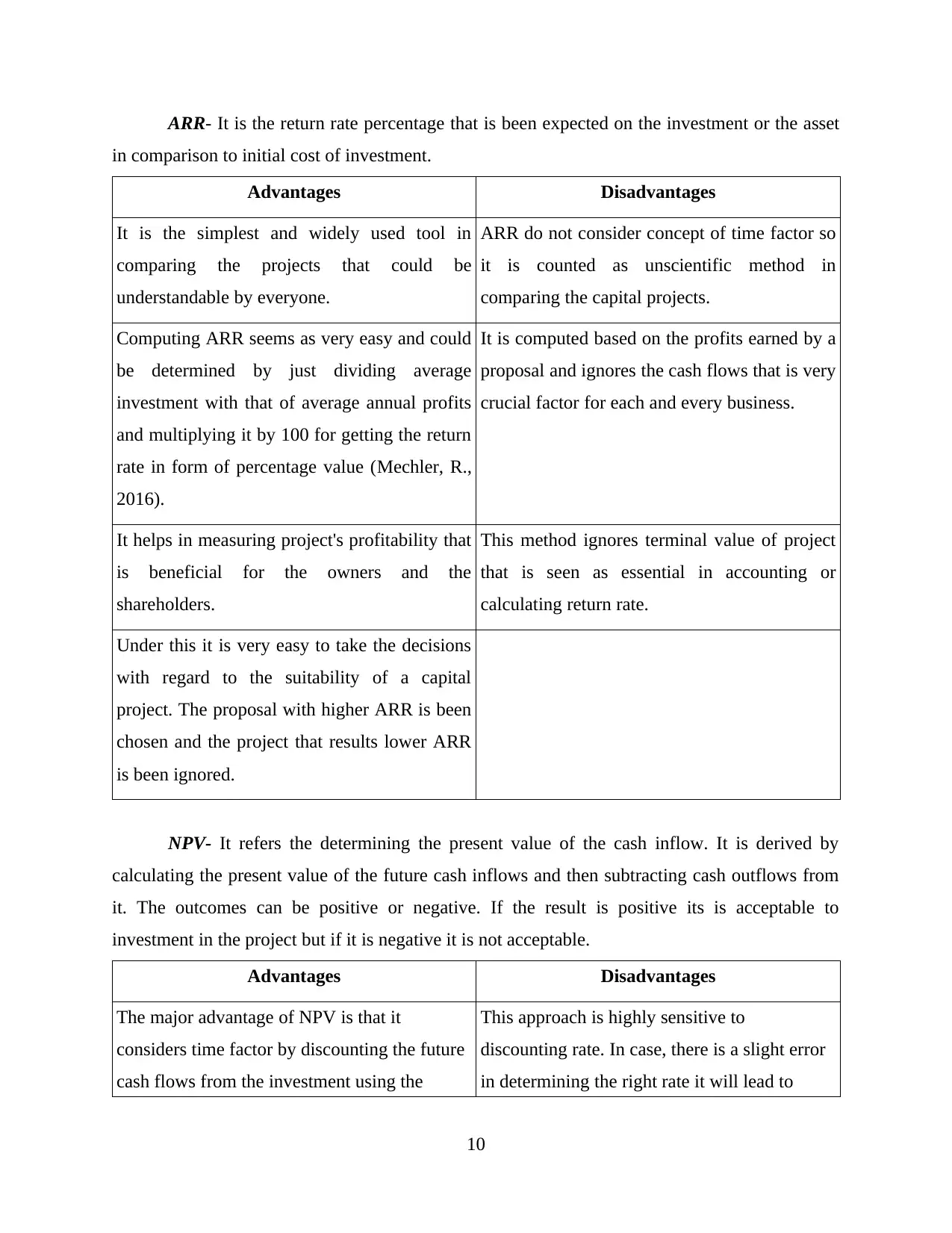
ARR- It is the return rate percentage that is been expected on the investment or the asset
in comparison to initial cost of investment.
Advantages Disadvantages
It is the simplest and widely used tool in
comparing the projects that could be
understandable by everyone.
ARR do not consider concept of time factor so
it is counted as unscientific method in
comparing the capital projects.
Computing ARR seems as very easy and could
be determined by just dividing average
investment with that of average annual profits
and multiplying it by 100 for getting the return
rate in form of percentage value (Mechler, R.,
2016).
It is computed based on the profits earned by a
proposal and ignores the cash flows that is very
crucial factor for each and every business.
It helps in measuring project's profitability that
is beneficial for the owners and the
shareholders.
This method ignores terminal value of project
that is seen as essential in accounting or
calculating return rate.
Under this it is very easy to take the decisions
with regard to the suitability of a capital
project. The proposal with higher ARR is been
chosen and the project that results lower ARR
is been ignored.
NPV- It refers the determining the present value of the cash inflow. It is derived by
calculating the present value of the future cash inflows and then subtracting cash outflows from
it. The outcomes can be positive or negative. If the result is positive its is acceptable to
investment in the project but if it is negative it is not acceptable.
Advantages Disadvantages
The major advantage of NPV is that it
considers time factor by discounting the future
cash flows from the investment using the
This approach is highly sensitive to
discounting rate. In case, there is a slight error
in determining the right rate it will lead to
10
in comparison to initial cost of investment.
Advantages Disadvantages
It is the simplest and widely used tool in
comparing the projects that could be
understandable by everyone.
ARR do not consider concept of time factor so
it is counted as unscientific method in
comparing the capital projects.
Computing ARR seems as very easy and could
be determined by just dividing average
investment with that of average annual profits
and multiplying it by 100 for getting the return
rate in form of percentage value (Mechler, R.,
2016).
It is computed based on the profits earned by a
proposal and ignores the cash flows that is very
crucial factor for each and every business.
It helps in measuring project's profitability that
is beneficial for the owners and the
shareholders.
This method ignores terminal value of project
that is seen as essential in accounting or
calculating return rate.
Under this it is very easy to take the decisions
with regard to the suitability of a capital
project. The proposal with higher ARR is been
chosen and the project that results lower ARR
is been ignored.
NPV- It refers the determining the present value of the cash inflow. It is derived by
calculating the present value of the future cash inflows and then subtracting cash outflows from
it. The outcomes can be positive or negative. If the result is positive its is acceptable to
investment in the project but if it is negative it is not acceptable.
Advantages Disadvantages
The major advantage of NPV is that it
considers time factor by discounting the future
cash flows from the investment using the
This approach is highly sensitive to
discounting rate. In case, there is a slight error
in determining the right rate it will lead to
10
⊘ This is a preview!⊘
Do you want full access?
Subscribe today to unlock all pages.

Trusted by 1+ million students worldwide
1 out of 15
Related Documents
Your All-in-One AI-Powered Toolkit for Academic Success.
+13062052269
info@desklib.com
Available 24*7 on WhatsApp / Email
![[object Object]](/_next/static/media/star-bottom.7253800d.svg)
Unlock your academic potential
Copyright © 2020–2025 A2Z Services. All Rights Reserved. Developed and managed by ZUCOL.





